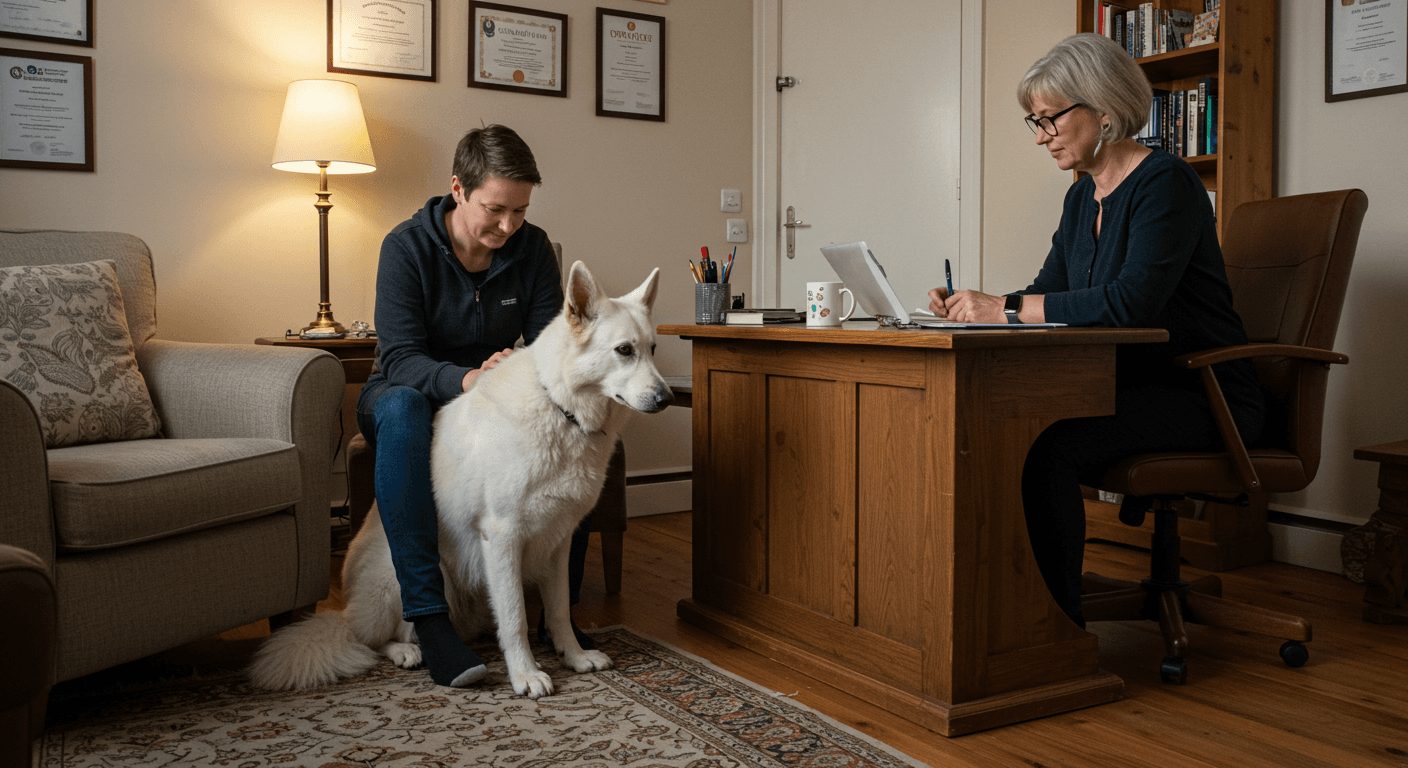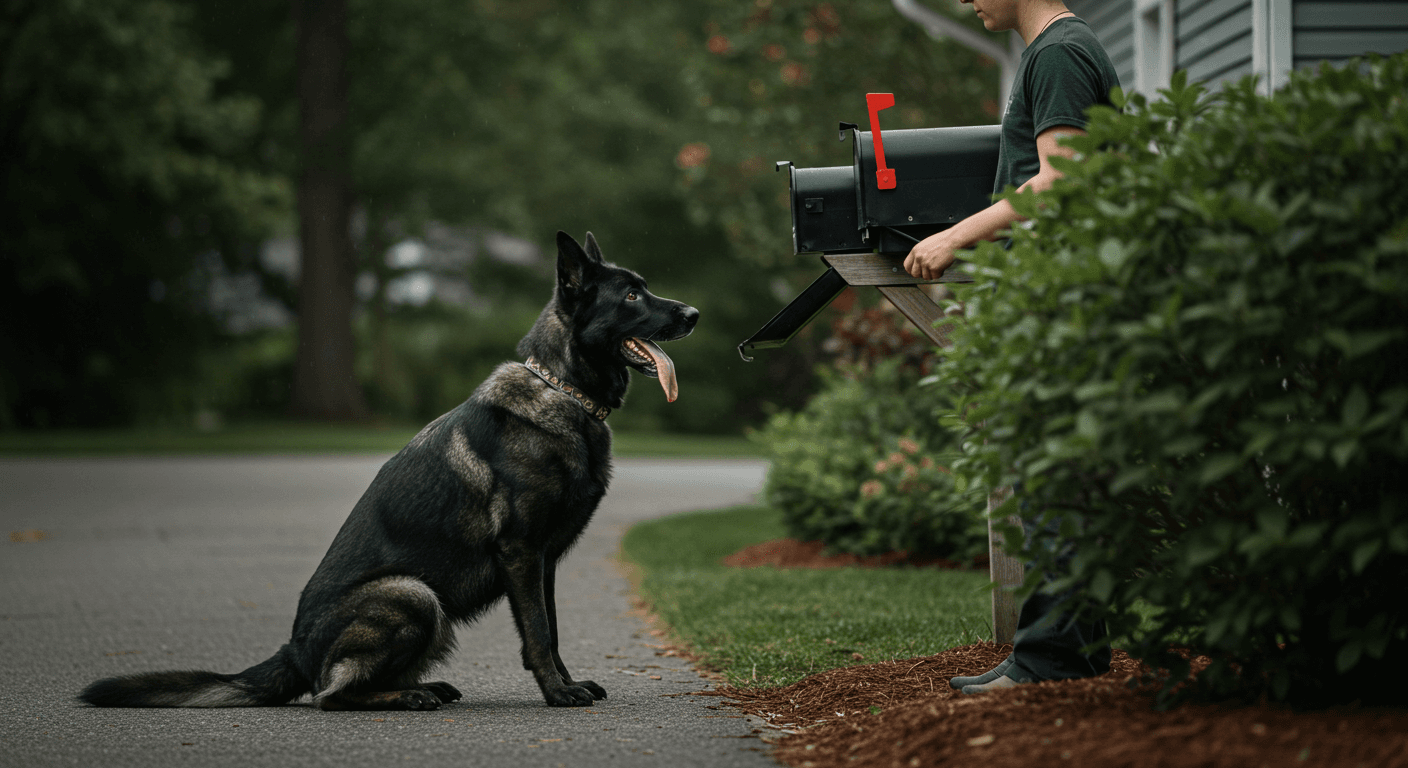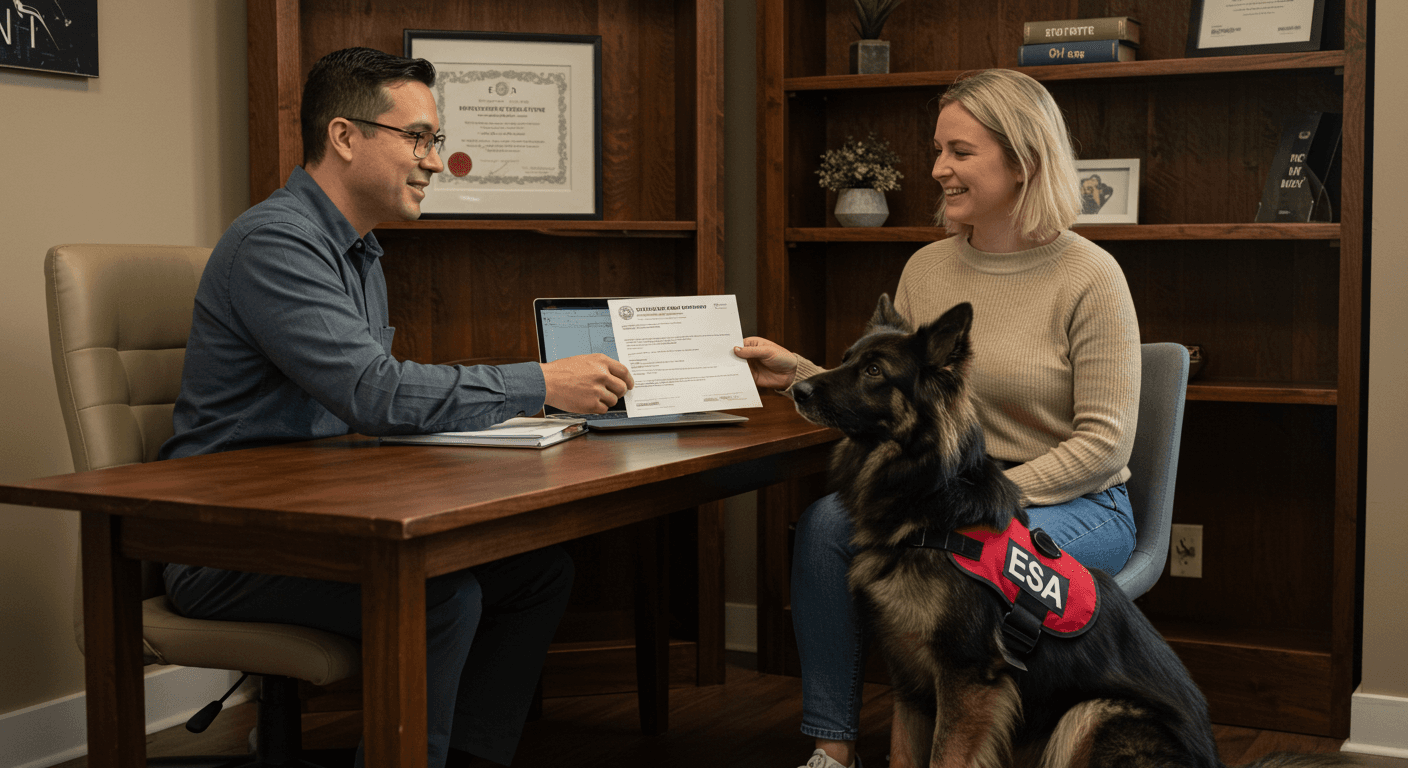Training an ESA dog can be one of the most rewarding experiences for German Shepherd owners. Whether you're looking for emotional comfort or a steady friend, your German Shepherd already has the loyalty and intelligence to become an amazing emotional support animal. But emotional support doesn't come automatically it takes the right kind of guidance, love, and structure.
In this 2025 guide, we’ll walk you through how to get your dog to be an emotional support companion. You’ll learn easy steps to help build the right behavior, boost your bond, and understand what's needed to make sure your German Shepherd meets the role with calm and care.
Many owners ask, “How do I make my dog an emotional support animal?” The good news is, it’s not as hard as it sounds. You don’t need your pup to perform tasks like a service dog. Instead, emotional support animals help with comfort especially in times of stress, anxiety, or sadness. And a well-trained ESA dog brings peace and structure to everyday life.
Throughout this guide, we’ll focus on practical, step-by-step tips made just for German Shepherds. These dogs learn fast and love to work, so they’re perfect candidates for ESA training. From basic commands to gentle manners, we’ll show you how to train your dog to be the best emotional support buddy you could ask for.
Understanding the Role of an Emotional Support Dog

German Shepherds are known for their intelligence, loyalty, and protective nature. These traits make them a great fit for becoming emotional support animals, or ESAs. But before jumping into emotional support dog training, it’s important to understand what this role really means and what your German Shepherd might be asked to do.
An emotional support dog is not the same as a service dog. While service dogs are trained to do specific tasks for people with disabilities, ESAs provide comfort and companionship. Their main job is to offer a calming presence to help with things like anxiety, stress, or depression. They don't need to learn special commands, but they do need the right training and behavior to excel in their role.
So, if you're wondering how to get your dog to be an emotional support, the first step is understanding the bond between you and your German Shepherd. Your dog should be calm, friendly, and able to handle different environments like loud places or crowded parks without getting scared or aggressive.
German Shepherds love to learn and work, so emotional support animal training can be a rewarding journey for both of you. With the right approach, you’ll help your dog grow into the role naturally. This includes using positive rewards, gentle corrections, and lots of patience.
Training an ESA dog starts with understanding why ESAs are so important. They offer more than love they offer daily emotional care that can truly improve their owner’s life. And with a breed like the German Shepherd, you already have a strong foundation for success.
How to Train a Dog to be an Emotional Support Dog?
Step 1: Determining Emotional Support Animal Eligibility

Before you begin training an ESA dog, it’s important to understand if your German Shepherd meets the emotional support animal requirements. This first step helps ensure you and your dog are on the right path from the start.
An emotional support animal (or ESA) is a pet that helps ease symptoms of anxiety, depression, or other mental health challenges. While any breed can become an ESA, many choose German Shepherds because they are smart, loyal, and easy to bond with.
To qualify for an ESA, you need a letter from a licensed mental health professional. This letter proves that your dog supports your mental well-being. It should be written on official letterhead and include your name, your condition, and a statement explaining why you need emotional support.
- Valid mental health condition – You must have anxiety, depression, PTSD, or a similar issue diagnosed by a professional.
- Licensed professional’s letter – A therapist, psychiatrist, or doctor must provide documentation for your need.
- Well-behaved dog – Your German Shepherd should be calm in public places and responsive to basic commands.
If you wonder how to get an ESA dog or how to get your dog to be an emotional support companion, this official recognition is the first move. Once you’re approved, you can begin focusing on the next steps in training your ESA dog to be the best helper possible.
Remember, emotional support animals don’t need special certification, but the letter makes them legally recognized under federal housing laws. Knowing the emotional support animal requirements upfront will save time and help guide your training journey.
Step 2: Getting Proper Emotional Support Animal Documentation

Before you begin training an ESA dog, you'll need to make sure your German Shepherd is officially recognized as an Emotional Support Animal. This starts with getting proper emotional support animal documentation. Without it, your ESA might not be protected under the laws that help people bring their animals into homes or on planes.
To qualify, you'll need a letter from a licensed mental health professional. This ESA letter must state that you have a mental or emotional challenge and that your German Shepherd helps ease the symptoms. Only certified professionals like therapists, psychologists, or psychiatrists can write this letter.
- Be honest during your evaluation – The more open you are, the better your provider can help.
- Choose a licensed professional – Make sure they are legally able to write ESA letters in your state.
- Avoid fake websites – Some sites sell documents that don't hold up legally. Always check reviews and credentials.
In addition to a valid ESA letter, it's helpful to understand emotional support dog requirements. While ESAs don’t need special training like service dogs, your German Shepherd should still be calm, well-behaved, and able to interact safely with others. Following emotional support animal requirements also means keeping your dog up-to-date on vaccinations and observing local pet rules.
Getting the proper paperwork is a big step that opens the door for further training. Once you have official emotional support animal documentation, you’ll be ready to focus on helping your pup become the perfect ESA companion for your emotional needs.
Step 3: Starting Basic Training for Your ESA Dog

Training an ESA dog starts with simple steps, and these are the moments where your German Shepherd begins learning how to become a helpful and calm emotional support animal. In Step 3, we’ll look at how to begin emotional support training the right way so your pup develops the behavior and habits needed to be an effective ESA.
Your German Shepherd is very smart and picks up new commands quickly, but it’s still important to begin with basics. Emotional support training doesn’t just mean teaching tricks. It’s about helping your dog stay calm, focused, and comforting in many different situations. That’s why starting with obedience is key.
- Sit and Stay Commands – These help your dog learn self-control and patience.
- Come When Called – This keeps your dog close when needed and builds trust.
- Leave It – Teaches them to ignore distractions or things that could be harmful.
- Walking Calmly on Leash – Helps avoid pulling or reacting to outside stress.
Keeping your training short and fun makes it easier for your ESA dog to stay focused. Aim for 10-15 minute sessions two to three times each day. Use happy voices, plenty of praise, and tasty treats to reward good behavior. This builds positive habits and teaches your GSD that training is a good thing.
If you're not sure how to begin or want extra help, look for “emotional support animal training near me” to find local trainers who understand ESA training. They can offer support tailored to your German Shepherd’s needs.
Basic obedience is the foundation of all ESA dog training. Once these steps are strong, you’ll be ready to move into more advanced emotional support training in the next stages.
Step 4: Reinforce ESA Behavior in Everyday Life

Once your German Shepherd learns the basics, the next step in training an ESA dog is to make those behaviors stick in everyday life. This means helping your pup use what they’ve learned outside of training sessions at home, on walks, or when visiting new places. After all, real emotional support animal training doesn’t stop on the couch; it happens throughout your day.
Your German Shepherd is smart, loyal, and eager to please. But keeping them consistent takes some daily effort. Don’t worry it’s easier than you think. The key is to create moments where your dog can use their ESA dog training in real-world situations. Let’s look at how to make those everyday moments part of their learning.
- Use daily routines for practice: Ask your German Shepherd to perform support tasks during regular events like making coffee, getting the mail, or bedtime routines.
- Reward calm behavior in different environments: Whether at a dog-friendly store or walking through a busy park, praise them for staying focused and calm.
- Stay consistent with commands: Use the same words and hand signals every time to avoid confusion.
- Gently correct unwanted behavior: If your dog gets distracted or excited, calmly redirect them to the correct task.
- Add variety to your outings: Practice emotional support animal training in new settings, like parks, pet-friendly stores, or quiet public spaces.
Training an ESA dog is not just about responding to commands. It’s about building trust and creating habits. By weaving ESA dog training into your daily life, you help your German Shepherd understand their role as a calming, reliable companion wherever they go.
Step 5: Renew ESA Status and Stay Legally Compliant

Once your German Shepherd has completed emotional support training, it’s important to keep their ESA status up to date. Step 5 of training an ESA dog is all about renewing their standing and making sure you follow all emotional support dog requirements. This helps ensure your furry friend continues to bring comfort while staying protected under the law.
In 2025, emotional support animal documentation must be renewed regularly. Just like doctor visits for your own health, your dog’s ESA status needs check-ups too. A licensed mental health professional (LMHP) must confirm that you still need your German Shepherd as your emotional support animal. This letter is typically valid for one year, so be sure to renew it on time.
Keeping up with current emotional support dog requirements not only helps maintain your legal protections, such as housing rights, but also shows that you’re a responsible dog owner. It's especially important if your GSD lives in a no-pet housing unit or if you want to carry them on flights where laws allow.
Here are simple steps to stay legally compliant with ESA laws:
- Renew your ESA letter yearly – Book an appointment with a licensed therapist or use a trusted online platform.
- Confirm your GSD’s behavior stays appropriate – Regular emotional support training helps your dog behave well in public and at home.
- Keep all records handy – Store physical and digital copies of your ESA letter and any training certificates.
- Check for law updates – ESA laws sometimes change, so check government or HUD guidelines annually.
Remember, even the best-trained German Shepherds need regular check-ins to stay emotionally supportive and covered by the law. When you stay on top of your emotional support animal documentation, you and your GSD can enjoy many more years of comfort and companionship without legal worries.
Training an ESA dog takes time, patience, and love especially if your furry companion is a German Shepherd. These intelligent, loyal dogs are well-suited for emotional support roles, but they still need the right guidance to succeed.
Throughout this guide, we’ve covered key steps for training an ESA dog, from understanding the basics of emotional support animal training to creating positive routines and practicing emotional bonding. By using positive reinforcement, staying consistent, and focusing on your dog’s emotional cues, you’re setting both you and your German Shepherd up for success.
If you’ve been wondering, “How to make my dog an emotional support animal?”, now you understand it’s more than just a letter it’s a daily journey of building trust and confidence. Whether you're just starting out or refining your methods, each step brings you closer to a deeper bond with your ESA.
Remember, German Shepherds thrive when they feel useful and connected. So, when training your ESA dog, always reward progress, offer clear commands, and maintain a calm, loving presence. You're not just training for compliance you're training for comfort, support, and life-long companionship.
Stay dedicated, stay patient, and your German Shepherd will become a reliable emotional support partner. Emotional support animal training isn’t just about the dog; it’s about creating a lasting relationship that brings peace, joy, and healing.



